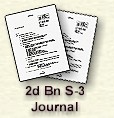|

0730 |
No enemy activity during the nite. F Co reports a booby trap set off.
finding enemy rifle, pistol and bloody stains. The Japs are still
carrying away their dead & wounded. They are burying their dead in
large caves. D Co unearthed two such caves yesterday. We suffered 2 WIAs
yesterday, one being Lt Mathers of F Co. There have been
no messages the past few days as Capt Taylor has been up at the front
directing operations
verbally. |

I spent the
early part of the morning with the M-7 commanded by 1st Lt
Glenn F. Gibson. The two tanks were parked on the road ahead of the M-7.
A brigadier general from the 40th
Division had given the tank commander a direct order to stay in front of
the M-7 and to move on Fentle's command. Gibson had a 20 power telescope
mounted on a
small
tripod. I had my binoculars. We lay on the road beside the M-7 scanning
the slope of the ridge we were preparing to attack. When we found a
black spot in the grass the gun would fire direct fire at this spot. A
large hole would be blown out revealing the remains of a bunker. The M-7
destroyed ten or twelve bunkers in a couple of hours. This would have
been a very difficult position to take had we attacked it with the
bunkers intact. It might have been more difficult than the line we
attacked the 21st. Now we were using our supporting weapons as we
should. We had to learn, though.
We had never
operated in open country with armor before. Armor could have been put to
great use on Corregidor saving lives. Imagine the effect one tank or M-7
would have had the morning of 23 February operating with "E" Company on
South Shore Road in the attack on Battery Monja. While Gibson and
I were studying the slopes of the ridge he called my attention to the
bottom of a draw near the trail which our engineers were converting into
Tokaido Road. There was a doorway leading into a small cave or dugout. A
Jap field grade officer was standing in the doorway looking our way
through binoculars. The reason we knew he was a field grade officer was
because he wore leather leggins, a leather belt, and leather shoulder
straps. I was closely watching him when he disappeared into a cloud of
smoke, dust, and flying timber due to a direct hit from the 105mm gun.
Later, after we advanced, some of the men found a leg encased in a
leather leggin.
During the
search and fire procedure Gibson had the tanks move forward two or three
times. The tanks were tightly buttoned-up, so he communicated with them
by the microphone hanging on the left rear of the tanks. The tanks never
fired a round that morning. As soon as we felt that M-7 had destroyed
the bunkers, I went over to the company and told Capt Taylor that we
were ready. The 4.2's fired a short barrage of HE and then smoke, and we
moved out. We were not fired upon. The M-7 had found and destroyed every
bunker. This was a classic example of the use of direct supporting fire.
Granted the situation was perfect for this support, i.e., the entire
slope was in view and in line with the M-7. |